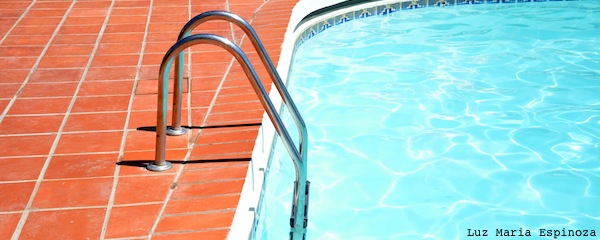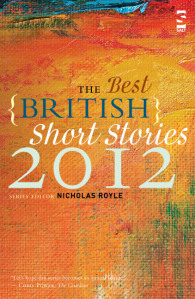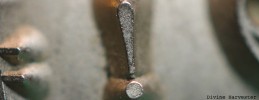
photo by Luz Maria Espinoza
by Carine Osmont
 Winner of The Macallan Short Story Dagger in 2002, for ‘Martha Grace’ (from Tart Noir), Stella Duffy has written around fifty short stories – fifty insights into human moments brought to us with warmth, empathy, humour or mischief. Her style is exquisite, exhilarating, and can also be provocative. Together, her stories form a luxuriant ensemble of psychologies.
Winner of The Macallan Short Story Dagger in 2002, for ‘Martha Grace’ (from Tart Noir), Stella Duffy has written around fifty short stories – fifty insights into human moments brought to us with warmth, empathy, humour or mischief. Her style is exquisite, exhilarating, and can also be provocative. Together, her stories form a luxuriant ensemble of psychologies.
‘To Brixton Beach’, published in The Best British Short Stories 2012, is one of Stella Duffy’s most fascinating short stories, particularly in the ways it ‘maps’ time and place. It does away with plot and action and tells of a day at the Lido, Brixton’s open-air swimming pool. As the hours go by, we meet several characters: Charlie and Sid, two brothers who go to the Lido to escape their suffocating and motherless home in Kennington; Mayneen, Elise and Monique who go to the Lido to watch and be watched; Helen who ponders her life as a mother; Margaret and Esther who have been going to the Lido for fifty years; Ameena who finds relief and strength in the pool.
Duffy shapes the map of the Brixton she lives in, its expectations, its depth of despair, and its permeable boundaries. Through the lens of humour, desire and suffering, she shows us the main characters’ efforts at resistance. As is often the case in her stories, the surface of the text appears deceptively simple, but we need only probe slightly deeper to become aware of her highly nuanced use of language and the possibility for rich interpretation.
Charlie climbs from the water now, his body his own again, reassembled from the wishing and the tears and the could be, might be, would be, from hope breathed out into water, from the grins of young men and the laughter of old women and the helpless, rolling giggles of toddlers on soft towels.
Charlie is not only a character, he is the spirit of the place. He is composed by its perceptions, emotions and experiences, both individual and collective.
 Duffy uses the recurrent motif of water in her stories to lead us into twists and turns, both external and internal at once. In ‘To Brixton Beach’, water carries smothered tears and ever blooming bunches of anger: ‘Margaret swims another twenty herself, head down this time […] screaming in the water because it was the only time Esther couldn’t hear her cry.’ It carries epiphanies, meagre ones, but stubborn ones: ‘Ameena loved swimming at school, has been denying herself the water since she decided to dress in full hijab. She does not want to deny herself any more.’ And water shapes life, at least for the character Charlie: ‘Behind him the water holds the memory of a man moving through it in cool midnight, a celluloid pool in which he flickers to life, and is gone.’
Duffy uses the recurrent motif of water in her stories to lead us into twists and turns, both external and internal at once. In ‘To Brixton Beach’, water carries smothered tears and ever blooming bunches of anger: ‘Margaret swims another twenty herself, head down this time […] screaming in the water because it was the only time Esther couldn’t hear her cry.’ It carries epiphanies, meagre ones, but stubborn ones: ‘Ameena loved swimming at school, has been denying herself the water since she decided to dress in full hijab. She does not want to deny herself any more.’ And water shapes life, at least for the character Charlie: ‘Behind him the water holds the memory of a man moving through it in cool midnight, a celluloid pool in which he flickers to life, and is gone.’
At the same time, ‘To Brixton Beach’ shows very beautifully how ghosts, past, present and future, excavate the memory of a place:
There are images in the water. The pool holds them, has held them, since it was built in the thirties and before. And before that too, when there were ponds here, in the park, ponds the locals used to bathe in. Men at first, then men and women, separate bathing times, of course. A pond before the pool, a house with gardens before the park, perhaps a common before that, a field, a forest. We can go back for ever. And on, and on.
The strength, the magic and the multi-voiced quality of Duffy’s writing invite us to project ourselves into the story – making it possible for us to relate to a character, an experience, or a feeling.
To read ‘To Brixton Beach’ in the context of Duffy’s entire work is to see a rich network of repeated imagery and motifs which give life and dimension to the forces of memory. Stories such as ‘The Body and The Land Are One’, ‘A Swimmer’s Tale’, or ‘Everything Is Moving’ create a similarly vast and rich dwelling place with a view on youth, dreams, grown-up realities and our desire for perpetuity. Duffy’s stories move us, they eat away at us with their humorous and honeyed sharpness, and they stay with us.
~
photo of Stella Duffy by Gino Sprio

